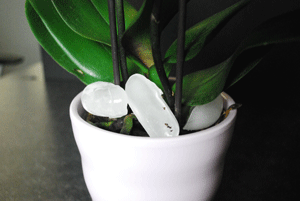 As is true for nearly all plants, orchids depend on three basic elements for their survival: water, light, and temperature. The bulk of orchid problems can be traced to too little or two much of one of these three components of orchid health. Like most orchid species, Phalaenopsis orchids and their hybrids have very specific requirements when it comes to growing conditions. If you provide your orchid with the correct amount of water, adequate light and proper temperature; it will thrive. Likewise, if your orchid starts to look a little peaked, look first to the three basics – water, light and temperature – for the source of the problem.
As is true for nearly all plants, orchids depend on three basic elements for their survival: water, light, and temperature. The bulk of orchid problems can be traced to too little or two much of one of these three components of orchid health. Like most orchid species, Phalaenopsis orchids and their hybrids have very specific requirements when it comes to growing conditions. If you provide your orchid with the correct amount of water, adequate light and proper temperature; it will thrive. Likewise, if your orchid starts to look a little peaked, look first to the three basics – water, light and temperature – for the source of the problem.
Phalaenopsis orchids do best when water is offered in small sips rather than big gulps. Overwatering is the No. 1 cause of Phalaenopsis failure. Tree dwellers in their native Southeast Asian habitat, Phalaenopsis orchids have aerial roots that obtain moisture from the humid air and nutrients from debris trapped in their tangled roots.
When you bring your Phalaenopsis orchid home from the store, take a close look at the “soil” in which it is growing. You’ll notice that your orchid is not potted in dirt but in loose, chunky, bark-like material that provides roots with proper air circulation and fast drainage, preventing exposure to standing water which can cause roots to rot.
Watering your Phalaenopsis orchids with three ice cubes once a week has two great advantages:
A note of caution: Just Add Ice Orchids are designed to be watered with ice. Other hybrids may not respond favorably to ice cube watering. Visit our website for more orchid care information.
Next time: Light

Copyright Just Add Ice® Orchids 2023